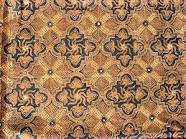THE HISTORY
Batik's true origin is still a mystery. The word 'batik' has been translated to mean 'to dot'. Some translated it as 'wax writing' or 'drawing with a broken line'.
It is a very old form of art, as evidence of early batik has been found in the Middle East, Egypt, Peru, Japan, East Turkistan, Europe, as well as Central Asia (India and China) as far back as 2000 years ago. Despite its uncertain origins, batik has reached its highest artistic expression in South East Asia, particularly in Indonesia and Malaysia.
Batik was first introduced to Europe in the 17th century when the Dutch, who colonized Java, Indonesia, introduced this art form to that part of the world.
WHAT MAKE BATIK SO UNIQUE ?
Batik is a crafted fabric that needs to undergo the delicate and repeated process of waxing, dyeing and boiling.
Wax is used as a mean of color blocking in the coloring process. Every part of the fabric that remains untouched by a certain color has to be covered with wax. There are also several sub-processes like preparing the cloth, tracing the designs, stretching the cloth on the frame, waxing the area of the cloth that does not need dyeing, preparing the dye, dipping the cloth in dye, boiling the cloth to remove wax and washing the cloth in soap.
The more colors a batik fabric has, the more times it has been through the process of applying wax, dyeing, and drying, then removing the wax. The process has to happen in a precise order that will produce the pattern or figures that are desired. Additionally, the order of which colors to apply also has to be followed.
Batik cloth can be made into garments, paintings, scarves, bags, table-cloths, bedspreads, curtains, and other decorative items.
Traditional batik is synonymous with silk or cotton. The re-introduction of natural dyes and technique has expanded the scope to include unexpected fabrics like chiffon, velvet, georgette, cheesecloth and voile mostly for fashion apparel. As for batik painting, the most commonly used fabrics are cotton and silk. There are various types of fabrics under these two categories such as poplin, voile, rayon, habotai silk, crepe de chine (cdc), jacquard and satin.
BATIK PRODUCTION TECHNIQUES
It can generally be divided into 3 types:
a) Canting (tjanting or tulis)
It involves outlining the designs using a canting, a metal pen tool filled with hot wax. Colors are then painted on the cloth and the process of the waxing, dyeing and boiling will be followed till the desired result is obtained. The process can take up to weeks depending on the intricacy of the pattern, which is why hand painted batik is so highly valued.
b) Cap (block printing)
It involves the application of wax directly onto the cloth using soldered tin or copper
strips block impressed with certain designs. The block, or "chop", is placed into hot wax and then hand stamped onto the fabric. When the wax is dry the fabric is dyed. Then the wax is removed and the pattern is visible.
c) Silk screening (screen printing)
Different screens are used according to the colors and patterns desired. The wax is applied onto the cloth using these screens. This printing method is usually used in the mass production of batik for commercial use.
BATIK AS AN ART
From a handicraft, batik has acquired the status of an art. Batik is a versatile medium that can become an ideal hobby for an amateur or a medium of expression for an artist. Batik as an art form is quite spontaneous and one can open up new vistas of creative form. Until recently batik was made for dresses and tailored garments only but modern batik is livelier and brighter in the form of murals, wall hangings, paintings, household linen, and scarves. If used properly, batik can make your house or office unique and inviting. Batik shall be kept in clean, tidy, neat, and regularly swept environment in the process of collection and maintenance.
Batik painting has gained popularity in recent years in the West. This painting is usually produced using the Canting technique. It has become a highly accomplished art form. Like oil painting, each Batik painting is a unique distinctive work of art.
As it is used as a wall decorative item for home and office, these batik paintings can be further enhanced by using


Tidak ada komentar:
Posting Komentar